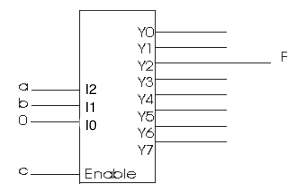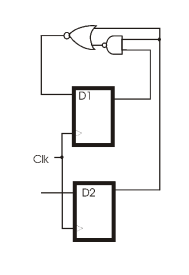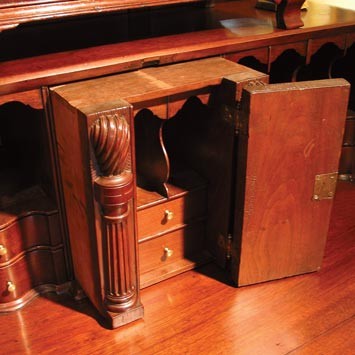Difference between revisions of "CSC270 Midterm Prep 2012"
| (4 intermediate revisions by the same user not shown) | |||
| Line 11: | Line 11: | ||
<br /> | <br /> | ||
| + | ---- | ||
| + | <br /> | ||
| + | |||
* Implement f above with NANDs only. With NORs only. | * Implement f above with NANDs only. With NORs only. | ||
<br /> | <br /> | ||
<br /> | <br /> | ||
| + | <br /> | ||
| + | ---- | ||
| + | <br /> | ||
| + | [[Image:SecretCompartment.jpg|150px|right]] | ||
* Assume that you have a desk with 3 drawers and a secret compartment. The drawers have electronic sensors that detect if a drawer is open (1) or closed (0). We want to build a simple circuit that will activate a release signal (set it to 1) to open the secret compartment only if the right combination of steps is taken. | * Assume that you have a desk with 3 drawers and a secret compartment. The drawers have electronic sensors that detect if a drawer is open (1) or closed (0). We want to build a simple circuit that will activate a release signal (set it to 1) to open the secret compartment only if the right combination of steps is taken. | ||
| Line 24: | Line 31: | ||
:# Drawer 2 is closed | :# Drawer 2 is closed | ||
| − | :At this point the release signal is activated. It stays on as long as none of the drawers | + | :At this point the release signal is activated. It stays on as long as none of the drawers moves. The secret compartment opens! |
;Question | ;Question | ||
| − | :How many states | + | :How many states does this FSM have? |
| + | <br /> | ||
| + | ---- | ||
<br /> | <br /> | ||
* Implement the function below with a 4-to-16 decoder. The decoder has active-low outputs and an active-low enable. Be efficient in your design. | * Implement the function below with a 4-to-16 decoder. The decoder has active-low outputs and an active-low enable. Be efficient in your design. | ||
| Line 33: | Line 42: | ||
::: f = Σ(0,1,3,4,5,6,7,8,9,10,11,12,14) | ::: f = Σ(0,1,3,4,5,6,7,8,9,10,11,12,14) | ||
<br /> | <br /> | ||
| + | ---- | ||
<br /> | <br /> | ||
| Line 38: | Line 48: | ||
enable inputs, and you are free to choose active-high or active-low signals. | enable inputs, and you are free to choose active-high or active-low signals. | ||
<br /> | <br /> | ||
| + | ---- | ||
<br /> | <br /> | ||
| Line 45: | Line 56: | ||
<center>[[Image:CSC270MidtermPrep1.png]]</center> | <center>[[Image:CSC270MidtermPrep1.png]]</center> | ||
<br /> | <br /> | ||
| + | ---- | ||
<br /> | <br /> | ||
| Line 52: | Line 64: | ||
<center>[[Image:CSC270MidtermPrep2.png]]</center> | <center>[[Image:CSC270MidtermPrep2.png]]</center> | ||
| − | |||
| − | |||
| − | |||
| − | |||
| − | |||
| − | |||
| − | |||
| − | |||
| − | |||
| − | |||
| − | |||
| − | |||
| − | |||
| − | |||
| − | |||
| − | |||
| − | |||
| − | |||
| − | |||
<br /> | <br /> | ||
Latest revision as of 16:01, 9 March 2012
--D. Thiebaut 08:40, 9 March 2012 (EST)
Below are some problems that will help you prepare for the midterm.
- Assume you have a boolean function f defined as:
- f = Σ(1,3,5).
- Give the maxterm canonical form of f.
- Implement f above with NANDs only. With NORs only.
- Assume that you have a desk with 3 drawers and a secret compartment. The drawers have electronic sensors that detect if a drawer is open (1) or closed (0). We want to build a simple circuit that will activate a release signal (set it to 1) to open the secret compartment only if the right combination of steps is taken.
- This combination of steps is:
- All drawers are closed
- Drawer 1 is open
- Drawer 1 is closed
- Drawer 3 is open and stays open
- Drawer 2 is open
- Drawer 2 is closed
- At this point the release signal is activated. It stays on as long as none of the drawers moves. The secret compartment opens!
- Question
- How many states does this FSM have?
- Implement the function below with a 4-to-16 decoder. The decoder has active-low outputs and an active-low enable. Be efficient in your design.
- f = Σ(0,1,3,4,5,6,7,8,9,10,11,12,14)
- Implement a 3-to-8 decoder with several 2-to-4 decoders. You may assume that the decoders have
enable inputs, and you are free to choose active-high or active-low signals.
- What is the boolean representation of the function f shown in the figure below? Express f in its
simplest form.

- What is the state diagram of the sequential circuit shown below, if D2 is set to 1 always? If D2 is set to
0 always?

